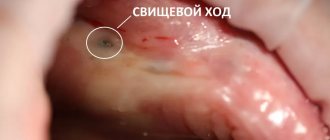Causes What to look for Diagnosis Treatment Home care
In some dogs (for example, chow chows), the purple color of the tongue is a congenital feature. If the dog’s tongue and mucous membranes were previously pink and suddenly turned blue, we are talking about cyanosis.
Cyanosis gives a bluish or purple tint to the skin or mucous membranes due to large amounts of hemoglobin that is poorly oxygenated. Oxygenated blood is red. When there is poor oxygen supply, the blood is dark blue.
Types of cyanosis
Experts distinguish two forms of the pathological condition:
- Peripheral cyanosis is a vasospasm that occurs due to prolonged exposure to cold or cold water, as well as due to low cardiac output (a condition in which the heart muscle pumps out less blood than necessary).
- Central cyanosis is a lack of oxygen saturation in the arterial blood.
The presence of a blue tongue in a dog indicates the likelihood of tissue hypoxia (oxygen starvation), however, this is not the only cause of cyanosis.
Diagnosis of thrombosis or embolism
In addition to the clinical picture, it is necessary to use special research methods for diagnosis.
Ultrasound diagnostics makes it possible to clarify the nature of occlusion and identify atherosclerotic plaques during thrombosis. Thrombosis differs from embolism in the initial damage to the arteries; in embolism, the arteries are most often not affected.
Angiography is performed on the operating table to clarify the receiving vascular bed and allows you to determine the nature of the surgical intervention
Multislice computed tomography is performed when there is time for a detailed diagnosis and allows you to very accurately identify the nature of the lesions and determine treatment tactics.
Prerequisites for the appearance
What causes a blue tongue in a dog? The following prerequisites for the occurrence of cyanosis are distinguished:
- decreased pulmonary ventilation due to diseases such as obstructive bronchitis, bronchial asthma, atelectasis;
- decreased oxygen supply through the walls of the alveoli due to diseases such as pneumonia, pulmonary edema, pneumosclerosis;
- deterioration of blood supply to the lungs, which occurs with heart failure or pulmonary embolism;
- poisoning with toxic substances;
- violation of venous outflow of blood;
- Congenital heart defect;
- narrowing of the trachea;
- hypertrophy of the velum;
- lung injuries that cause fluid to accumulate in an organ or chest cavity.
There are many reasons for a dog's blue tongue and they are all quite serious, so this symptom should not be ignored. In addition, a predisposition to these diseases exists in breeds such as Pekingese, Boxers, Pugs, Yorkshire Terriers, Shih Tzus, and Toy Terriers. Owners of these animals need to carefully monitor the health of their pets.
Angiography
To resolve the issue, surgical tactics require information about the patency of the arteries of the affected limb. The choice of technique for restoring blood circulation depends on the condition of the inflow pathways to the affected limb and the vascular bed below the site of blockage. In addition, angiography can distinguish embolism from thrombosis against the background of atherosclerotic narrowing. During an angiographic examination, endovascular treatment can be undertaken in the form of thrombectomy and angioplasty of the affected segments or local thrombolytic therapy can be performed.
Arterial embolism is an acute blockage of a vessel by a thrombus or other object brought from other parts of the vascular bed. Most often, vascular surgeons deal with thromboembolism from the heart cavity during a heart attack or atrial fibrillation, from the cavity of the aneurysm of the vessel overlying the blocked artery.
Consequences of acute cessation of blood flow
The sudden cessation of blood flow leads to the phenomenon of acute ischemia. The organs and tissues that are supplied by this artery lack nutrition and oxygen, so they begin to slowly die. The most specialized tissues are affected first—nervous, muscle, and finally skin. The body tries to restore blood circulation by opening additional bypass pathways for blood flow, so sometimes tissue death is stopped. But the likelihood of such an outcome is low. In any case, acute ischemia leads either to gangrene or to the development of chronic circulatory deficiency - critical ischemia.
Symptoms of pulmonary diseases
An attentive owner will definitely notice that the dog’s tongue has fallen out and turned blue; in addition, the disease can be suspected by the following manifestations:
- the animal is less active, not interested in food and toys;
- heavy breathing, which in some cases may be complicated by foaming at the mouth, wheezing or coughing;
- breathing is carried out primarily through the mouth.
Breathing may also be intermittent and there may be delays. If a dog's tongue falls out and turns blue, this means that the animal has problems with the lungs and respiratory system.
STRESSED AND SWITCHED BEHAVIOR IN DOGS
Stress is the disease of the 21st century... We agree, people call stress one of the main problems in our lives. But somehow we forget that our smaller brothers are also subject to stress. And, unfortunately, we don’t always try to make the situation easier for them; often, out of ignorance, we make it even worse...
STRESSED AND SWITCHED BEHAVIOR IN DOGS It may not even be worth dividing a dog’s behavior into stressful and switched-out behavior. After all, they are often strongly interconnected; it is stress that causes switched behavior. As a matter of fact, a dog that is under stress and does not have the opportunity to relieve stress with adequate behavior, and is unable to withstand internal tension, SWITCHES its actions to an object that is in no way related to the source of stress. Recently, the word ADEQUATE (and inadequate) has spread to characterize the behavior and reactions of people and dogs. Adequate means “appropriate” - when responses correspond to the strength of the stimulus and behavior corresponds to the situation as WE imagine it. If, from our point of view, the manifestations of reactions do not correspond to the situation, the behavior (and the person) are characterized as inadequate. For example, someone can be instantly enraged by a seemingly innocent remark, and a person who flies into a rage over a trifle gives the impression of being inadequate. But upon closer examination, it may turn out that this person had reason to be furious if this remark, innocent for others, deeply concerns his personality, is, so to speak, a pet peeve that has been crushed many times before. Unfortunately, the dog cannot tell us what exactly knocked it out of its normal behavior and explain the misunderstanding. Therefore, it is very easy for her to be labeled as inadequate. At the same time, her reactions are exactly adequate to her state of mind and situation, WE just don’t know all the circumstances leading to a breakdown. Precisely a breakdown, because in dogs mental illnesses and anomalies are extremely rare and the vast majority of so-called inadequate reactions are caused by acute or chronic stress. Most dogs tolerate stress less well than humans. On the one hand, they are not tormented by the problems of the future: what to do if we get laid off, how to get our son out of a bad company, or how to overcome the cooling of marital relations. On the other hand, they are not aware of the circumstances and cannot know that the cause of their stress is absolutely harmless; they cannot tell themselves in spirit: calm down, nothing terrible is happening! They cannot relieve stress like we do: listen to music, read a book or take up knitting.
Or at least relieve stress by taking out your anger on an innocent dog, slamming your fist on the table, or kicking the wall well. The last two examples, by the way, are classic examples of switched behavior.
STRESS Stress usually refers to the impact of external and internal stimuli that lead to disruption of the dog’s mental balance. External - noise, frightening objects, sharp flashes of light, actions of people or other dogs that are unpleasant for the dog. Internal - pain, feeling of a full bladder, cold, hunger. In fact, any organism is always affected by some kind of stress factors. If their impact does not cross a certain limit, the body copes with stress. Moreover, a certain level of stress is necessary, it stimulates the development of the brain, since it stimulates the activity of the subject (and in our case the dog). Simply put, if we feel good, there is no incentive to move and wiggle our brains in search of a more comfortable position. But when we feel bad, we develop activities aimed at avoiding the bad and searching for the good. This way we develop our brain and gradually increase our resistance to stress. But if the strength and duration of stress exceed the body's safety margin, stress leads to disruption of its normal functioning. Especially long-term stressful conditions lead to disorders - and not only of the nervous system, but also of other organs and systems. It’s not for nothing that people say: all diseases are caused by nerves. In severe illnesses, stress can literally kill, since severe physical suffering deprives the sick animal (and humans too) of the will to live. Any doctor will tell you that a calm environment and the removal of physical suffering increases the chances of recovery and speeds it up. Resistance to stress is individual for everyone and depends not only on genetic factors, but also to a large extent on growing and maintenance conditions. Unfortunately, many owners themselves create a predisposition in their dogs to stress reactions. Keeping a puppy confined to four walls for too long under quarantine conditions, in an environment poor in irritants, leads to the fact that when he later finds himself on a noisy city street, he is unable to cope with the abundance of strong irritants. The same thing happens when raising a dog at the dacha - when it later gets to the city, it becomes very stressed, since the psyche, which is fragile in the greenhouse conditions of a quiet dacha, cannot cope with such stress. Unfortunately, if time is lost, the dog will never learn to cope with stress easily. You cannot build a fortress on a weak foundation...
MANIFESTATION OF STRESS
Stress manifests itself both through autonomic nervous reactions and external manifestations. These manifestations can be very diverse. It starts with little things: the so-called “flicker of the tongue” - when the dog licks his upper lip and nose with a quick movement. Acute stress is accompanied by rapid breathing and drooling. The shortness of breath may be so severe that the dog's tongue turns blue. Cyanosis leads one to believe that the dog has something wrong with its heart or lungs. In fact, a strong release of adrenaline into the blood leads to constriction of blood vessels, blood flow in the periphery is hampered and lack of oxygen causes blueness. A dog in such a state of stress usually trembles, his eyes dart around in fear, his tail is tucked, and he stops responding to commands, giving the impression of being insane. Some people try to run away and hide, while others, on the contrary, seek help from loved ones. By the way, a dog reacts to stress in a similar way with a + sign. In puppy delight he runs around, not listening to admonitions, running into people and objects, puffing, squealing and urinating under himself. Unfortunately, joyful stress can also kill: unable to bear the joy of getting ready for the dacha, eight-year-old Reda died of an acute heart attack just after jumping into the car... The manifestations of chronic stress are outwardly more smoothed out and often inattentive owners simply do not notice them. Or they are attributed to the dog’s stubbornness, stupidity, maliciousness, or “inadequacy.” For example, a dog under stress begins to make mistakes when executing familiar simple commands, slows down the pace of their execution, or begins to ignore them. Instead of giving the dog a rest or simply switching to another type of activity for a while, they begin to “put pressure” on it and thus only aggravate the stress. A very common stress response is urination. Not only in a state of acute stress, when a frightened dog pees under itself. Dogs urinate in conflict situations, thus defusing the situation. For example, if it is impossible to reach an enemy barking from under a fence. Or, if necessary, approach a clearly angry owner - quite a few dogs immediately remember one small but urgent matter... A puddle at home is not a rare occurrence in dogs experiencing the stress of loneliness. It manifests itself in the fact that a dog, trained to maintain cleanliness, without any problems enduring half a day from walk to walk when the owners are at home, makes a puddle after they leave for 15 minutes to the next stall. This is especially common in dogs that have experienced trauma, such as the loss of an owner. Having found someone new, they become so stressed when they leave home that they involuntarily relieve stress by throwing a puddle, even if only symbolically. Stress can manifest itself in more than just depressed and passive behavior. On the contrary, frustration can manifest itself as irritability and increased aggressiveness. And you are not the nicest and most patient when you are unfairly yelled at or have a toothache for three days.
A DOG UNDER ACUTE STRESS An example of stressful behavior in a dog. We came to the shelter to pick up an adult dog, a fairly young Rottweiler. Male, very large, temperamental and has been living in a shelter for a year. In conditions of chronic stress from lack of movement and lack of communication. Naturally, the dog lacks education; the shelter workers simply cannot train it. As it turned out, none of the shelter workers knew the dog closely; the dog saw its potential owner for the second time in its life. The day at the shelter turned out to be particularly hectic and nervous; two new dogs were brought in, two were taken away, and one dog was brought in for castration. The dog that was about to be adopted is locked for some time in the procedure room where the operation just took place. An already nervous dog, sensing the unusualness of the situation, in a procedure that smells of blood and fear of another dog, begins to get even more nervous and begins to tear and destroy the environment of the first aid station (switched behavior). In addition, several people, confusedly rushing around him, do not help him calm down in any way - all of them are little known to the dog and do not have enough experience. The sedative pill didn’t help either, because the dog was overexcited and the adrenaline in its blood went through the roof. They try to give the dog an injection, but at the same time they overstimulate it even more. The dog is nervous and does not allow the muzzle to be put on, showing defensive aggression. He is not aggressive, he is just afraid and wants only one thing: to be left alone. Then someone comes up with the “amazing” idea of putting a bucket on his head. Moreover, there is a simple and reliable method of restraining dogs, described in textbooks on veterinary medicine: a short leash at a post with simultaneous fixation by the tail (this Rottweiler’s tail was not docked) or by the lower back. The bucket achieved only one thing - the dog, having lost the opportunity to see what was happening, came into a state close to panic, began to fight, the broken plastic bucket flies to the side, and the injection was never given. Then they still give the injection (after receiving advice on fixation), but the dog is already very nervous and the injection works slowly. She should be given peace and the opportunity to fall asleep without unnecessary worries, but she is constantly being tugged, pulled, and screamed at. The dog feels that something incomprehensible is happening to him and then the remnants of consciousness (the poor fellow is almost insane) cease to cope with the situation - a failure occurs. He clings to the hand holding him with the desperation of a suicide bomber, clenches his jaws and tears like a wounded animal in agony, not understanding the commands that the same frightened people shout at him. Someone finally shouts: Water!!! And he receives...a full canister, which, without even opening it, is thrown at the dog. Finally, the dog unhooks and falls in complete mental shock and physical exhaustion. Everything could have ended differently, without physical and mental harm for both, if stress had been minimized for the dog from the very beginning. If only she had not been locked up in a cramped first-aid post, smelling of blood and pain, but taken for a walk, as usual, before getting into the car. They gave me time to calm down after taking sedatives. They wouldn’t scream and rush around in front of her, increasing stress to a critical level. As a result, the promising owner left without the dog, but with a fairly serious injury, and the dog remained in the shelter with the risk of being branded inadequate and much less likely to be adopted. SWITCHED BEHAVIOR When the degree of stress increases and the psyche ceases to cope with it, defense mechanisms are activated, including switched behavior. Internal tension breaks out, looking for a way out - like electricity along a lightning rod, following the path of least resistance. When a dog cannot leave or get rid of stress, eliminating its source directly, it directs actions to another object, chooses another, accessible type of activity. At first glance, it has nothing to do with the cause of stress. Her behavior looks incomprehensible and illogical when applied to the circumstances. Pointless. A person solves stress in the same way, and unconsciously. For example, sitting in a doctor’s waiting room, someone whiles away the time by biting their nails, someone crumples and folds a piece of paper, someone fiddles with a handkerchief. A dog, suffering from idleness and loneliness, chews bedding or shoes, licks its paws to bald spots, and tears wallpaper or baseboards from the walls. Moreover, gradually destructive activity can intensify to obsessive states, when the dog becomes literally insane and is no longer able to stop. Switched behavior, like emotions, can be “contagious.” I remember we met before a walk at an appointed place and for some time we had to wait for a late friend. The dogs were languishing in anticipation of a walk, especially our active and energetic leader. The horse digs its hoof impatiently. Frank, having no hooves, found entertainment in biting the root shoots of the maples growing there. He bit the rods with frenzy, and soon other members of the pack joined him. They stopped fussing and running around, all concentrated, with a blank expression on their faces, they literally cut the growth down to the very butt of the trunks. And not only at the usual meeting place. Now, as soon as you stopped anywhere along the walk route for more than a few minutes, the dog house scattered at the nearest bushes and cut, cut, cut... Later, when the snow fell deep in winter and there was nothing left to cut, one of the dogs found a new kind of fun: gnawing randomly thrown cardboard boxes there, and a whole flock, as if on command, rushed to tear up the soaked cardboard with no less enthusiasm with which they had previously trimmed the bushes. Waiting appears to be as stressful for dogs as it is for humans. Dogs in general react to many stressful situations in a ridiculously similar way to people, and this is no coincidence. Many human reactions have developed from natural, subconscious behavioral complexes characteristic of many animals. This is why we humanize dogs so easily and why, with a little experience, we can easily interpret a dog’s seemingly incomprehensible behavior. For example, just like us, dogs can take out their irritation on other objects, so to speak, take it out on a suitable scapegoat. A typical situation: there are dogs sitting behind the fence, which furiously bark at all the aliens passing by. They respond in kind, angrily swearing through the fence. A dog walking down the street is deprived of the opportunity to hang pretzels on the impudent mongrels, so out of frustration he will at least stop for a minute and “demonstrate his attitude” towards them: he will pee right under the nose of the furious owner of the site. The owner of the plot, outraged by such insolence, cannot grab hold of the impudent stranger, but so begins to furiously bite off and throw aside the branches of the currant entrusted to him for protection. Switched behavior - one of the dogs switched aggression to marking territory, the other switched aggression to an innocent currant. We continue down the street. Behind one of the fences are two huskies, a male and a female. In fact, they live in perfect harmony, and now they rushed at the stranger together as one. (Husband and wife are one Satan...) Frank points his teeth through the fence and utters threats. The indignation of the owner and the husband culminates, but he cannot fight Frank in battle, and so he turns around and... slaps the unfortunate wife. Like, all sorts of people walk around here, and you’re also getting underfoot here... clumsy! How humane! So the head of the family, having received a good scolding from his boss at work, comes home on edge and takes it out on innocent members of the household...
CAUSES OF STRESS ARE OFTEN IN US In the lives of each of us, both humans and dogs, there are enough sources of stress. It is all the more incomprehensible and unpleasant that our neighbors become an additional source of stress for us and, instead of relieving stress, they contribute to its increase. Coming home from work on the verge of mental and physical exhaustion, we long to find peace and the joy of meeting, affection and understanding. But instead we find new boots chewed up... But, of course, things happen. The dog, by relieving its own stress, without realizing it, increased our stress. And again, in the end, it’s yours, because many owners in this situation, without further ado about the motives of the dog’s behavior, will beat it with that same chewed boot. At the same time, most owners do not think that, in addition to many other reasons, they themselves become the cause of chronic stress for their dog. We put too much pressure on dogs, wanting to remake them in our own way and forgetting that dogs are built differently and simply CANNOT adapt 100% to our inflated demands. We are not perfect either, but for some reason we expect this from dogs. The dog is a social animal, highly intelligent. She suffers greatly from loneliness and boredom. Left alone all day, she cannot simply lie on the mat and meditate or indulge in philosophical discussions. He sleeps most of the day, of course (dogs need to sleep more than we do), but the remaining hours of idleness are very difficult to bear. When you get home, you give her a quick cuddle and take her for a short walk. A walk for a dog is a great way to relieve the frustration of idleness and satisfy the hunger for information... but if it’s just a short walk on a leash with constant tugging, it won’t relieve his stress. This is impossible, this is impossible, jerks, shouts, the irritated owner literally drags the dog into the entrance - barely she had time to fulfill her physiological needs. Dear owners, put yourself in the dog’s place, at least mentally, for those 10-15 minutes of walk. Imagine that you sat alone for 8-10 hours, with a full bladder and consumed by boredom, and now you have a quarter of an hour to do everything about everything. To go to the toilet, to exchange news with a friend who happened to go outside at the same time, to re-read new comments on your post on local Facebook, to stretch your bones a little and glance out of the corner of your eye at a beautiful stranger - before you again distracted between four walls. And they will leave you alone again, because the owner considers his duties fulfilled and will communicate with the TV or computer. Excessive fuss can also cause stress. Dogs are sociable creatures, but everything is good in moderation, and so is communication. There are dogs who adore the atmosphere of exhibitions, competitions and mass celebrations, but there are not many of them. Most dogs feel awkward in a large group, especially unfamiliar ones. Even if the guests are happy at the beginning of the party, the prolonged celebration tires them and they begin to get nervous. Especially if the guests are tipsy and intrusively offer the dog communication. They say that dogs don't like drunks, but who does? They cause stress for us too. There are people whom we can tolerate in small doses and others whom we cannot tolerate at all. It is precisely because they are unbearable that they DO NOT FEEL us, they do not know when to stop, to ease the pressure on us. This is exactly how we often behave towards our dogs. The difference is that we can avoid people who are too persistent and tactless, but our dogs cannot avoid us and are forced to adapt to us. Paying the price with stress.
WHAT TO DO?
They say: live and let others live. Try to be more tolerant with your dog and allow him, if possible, to remain a living dog with his shortcomings, and not a mechanical toy. Forgive her for her childish spontaneity and minor sins, allow her to be a little stubborn sometimes and do not subject her to too strict rules. Sometimes a dog also needs to relax and be alone. Separate the areas of communication: time for business and time for fun. After all, you also divide life into formal (in the service) and informal (outside the service). A dog cannot live its entire life on command. Find time for affection and games, communicate with your dog not only as a trainer, but also as a friend. Understand that she is not meant to please you 24 hours a day; she may also have a bad mood and poor health. Do not be annoyed if she pulls you on a leash; after sitting at home, she is in a hurry to explore the territory. Try to understand WHY she acts the way she does before you label her behavior as problematic and start “fixing” it.
It is not always possible to knock out a wedge with a wedge. If you see signs of stress in your dog, do not push him or increase his stress level even more. A nervous breakdown may occur with long-term consequences, and this may not appear immediately, but after several hours, days or even weeks. An example of a delayed effect would be the sudden fear of exhibitions and similar noisy gatherings in dogs that have not previously shown significant fear. Moreover, over time, the fear does not go away. Instead of getting used to the noisy atmosphere, the dog becomes more and more afraid. Therefore, if you notice your dog’s mental discomfort, stop exercising and figure out what’s causing him stress. If you eliminate the cause of stress or help the dog by switching behavior in a different direction to reduce its level, behavior problems will most likely disappear on their own. In severe cases, the break can last for weeks or months, but it is better to miss several exhibitions or competitions than to consolidate changes in the psyche and make them irreversible by premature continuation and new stress. Drug treatment does not always help, but there are situations when sedatives are necessary. For example, if your dog has a hard time with the popping of firecrackers, it is better to give him sedatives in advance before the approaching New Year holidays.
In any case, there is such a thing as “transfer of emotional states.” If you're nervous, don't expect your dog to be a model of calm. But your confident appearance and calm voice calm the dog; gentle and calm treatment blocks not only fear, but also aggression. Dogs are very sensitive to our emotional states, so try to control yourself if you are scared or angry. It is not for nothing that they say that a dog is a mirror of its owner. Our problems, unfortunately, are reflected on our smaller brothers, therefore, as popular wisdom says, there is no point in blaming the mirror if...
Symptoms of diseases of the cardiovascular system
Not only respiratory diseases can cause a blue tongue in a dog. Cyanosis is also observed in animals suffering from problems with the cardiovascular system. This can be determined by a combination of the following symptoms:
- dyspnea;
- cough;
- a dog's blue tongue;
- swelling of the limbs;
- ascites (accumulation of fluid in the abdominal cavity);
- rare pulse;
- weight loss;
- change in heart rate.
At the same time, general changes in the animal’s behavior are noticeable: decreased activity, loss of interest in food, toys and other external stimuli. The symptom of a half blue tongue in a dog may also indicate problems with the cardiovascular system.
Molluscum contagiosum in children
Molluscum contagiosum is more common in children than in adults. Children up to one year old practically do not get sick with molluscum contagiosum. This is due to the fact that in the first year of life the child’s circle of contacts is small: the child moves in a limited space, often specially prepared for him and under the strict supervision of adults, without trying to come into contact with other children. But as soon as a child begins to actively communicate and independently explore the world, the threat of becoming infected with molluscum contagiosum increases sharply.
The peak incidence of molluscum contagiosum in children occurs between the ages of 2 and 6 years. Immunity at this age is still weak. Children become infected through toys or dirty hands. The virus penetrates the skin in the place where the integrity of the skin is damaged - through wounds, abrasions, cracks. Children's skin is delicate and sensitive, and the activity of a preschool child is great. As a result, numerous microtraumas occur, opening the way for infection. Cases of infection with molluscum contagiosum while swimming in the pool have also been described.
From 6 to 10 years, the incidence of molluscum contagiosum decreases. Instilling household hygiene skills is of great importance. The sooner your child starts taking care of clean hands, the better.
Treatment of pulmonary diseases
Why and why a dog has a blue tongue is described above. How to cope with diseases of the respiratory system that can cause such a pathological condition?
- For respiratory diseases and rhinitis that make it difficult for the animal to breathe, the following treatment is used - the antibiotic Ampicillin, the antiallergic drug Suprastin and nasal drops Anandin.
- For laryngitis (inflammation of the larynx), medications such as Prednisolone and Suprastin are used; the larynx must be lubricated with Lugol's solution or sprayed with Ingalipt.
- Bronchitis is treated with the following medications - Ampicillin, Prednisolone, Suprastin, Bromhexine, Eufillin, Mucaltin.
- For pneumonia (pneumonia), the following treatment is effective: antibiotics Cefazolin, Gentamicin, intravenous infusion of Furosemide solution to prevent pulmonary edema, drugs to maintain cardiac function (Digoxin, Cordiamin).
- Pleurisy (inflammation of the pulmonary membrane) requires the following therapy - antibiotics "Cefazolin", "Gentamicin", painkillers "No-shpa", "Baralgin", expectorants, diuretics. If there is a large accumulation of fluid, it must be removed surgically.
The need to use a particular drug, as well as the dosage (based on the dog’s weight), can only be prescribed by a qualified veterinarian; self-medication can be dangerous to the pet’s health.
Treatment of heart diseases
If a dog has a blue tongue, what should you do in this case? It is important to have the animal checked by a veterinarian for pathologies of the cardiovascular system. What diseases can be detected? How to treat them?
- Cardiomyopathy, unfortunately, cannot be completely cured. However, you can improve your pet’s well-being with the following medications: the diuretic Triampur and the heart medicine Digoxin.
- Myocardial infarction is treated with the following drugs - to maintain the activity of the heart "Digoxin", "Prazosin", for edema "Lasix", "Eufillin" and "Quinidine sulfate" for arrhythmia.
- Myocarditis requires the following therapy - injections of Sulfocamphocaine, as well as antibiotics to treat the primary focus of the disease.
- In case of chronic heart failure, medications are needed that support the functioning of the heart muscle in normal rhythm. "451"[/img]
In addition, it is important to adhere to a salt-free diet and nutrition regimen. If your dog is overweight, it is necessary to consult a veterinarian for further weight loss, since obese animals significantly increase the load on the cardiovascular system.
When is blue tongue normal?
Although such an unnatural shade of mucous membranes may signal health problems, there are dog breeds that have a blue tongue as a feature. These are dogs such as Chow Chow, Shar Pei, Eurasier.
Today, the reliable reasons for such an unusual color of the tongue and mucous membrane of these breeds are unknown, but there are also legends on this topic that originated in the homeland of these animals.
If the pet does not belong to the types of dogs described above and its tongue has acquired a blue tint, then it is necessary to urgently show it to the veterinarian, as this indicates the presence of health problems.











